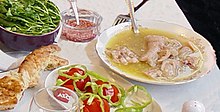Chash
Chash is a traditional dish of Armenian cuisine that is known throughout the Transcaucasus . The main ingredient is cow's feet . It used to be a nutrient-rich food for poor people in the winter months. Today it has become a delicacy . It is enjoyed as a festive meal in the cold season.
A similar dish is piti in the area of the Turkish Kar province , which was previously mostly inhabited by Armenians . Sheep's claws are usually boiled with the same preparation .
etymology
The noun Khash ( Armenian Խաշ ) comes from the Armenian verb "chaschel" in its meaning to cook from. Khasch or Chash is also used as a German spelling.
preparation
Chasch is prepared as a pure meat dish with few ingredients. The main ingredient is cow's feet, the head and stomach are also used. The cow's claws (in Armenian totikner ) are depilated and cleaned. They are then placed in cold water until they are free of the strong odor. It is boiled in clear water for one night. The resulting strong broth was cooked without salt and spices, after the long cooking time the meat falls off the bone. The food is served hot and therefore eaten in the morning. The eater takes on the seasoning individually with the provided salt, garlic , lemon juice and table vinegar . Often, dry lavash is broken up and added to the broth until it becomes a thick paste. Chasch is served with a variety of side dishes, including green and yellow sweet peppers , hot peppers , pickled and pickled cucumbers , radishes , cream cheese , green salads and garden herbs such as cress or rocket . Vodka , preferably mulberry vodka , and in Armenia also brandy and mineral water are offered with the meal . For this reason, chasch is seen as a men's meal, as the high gelatin content is attributed to women.
consumption
Armenian families generally invite guests to eat hash. In Georgia , it is often offered after a festivity as it is considered a hangover breakfast . The traditional time for a hash is the morning hours. Previously, the "poor people" took the leftovers of the rich who only ate the meat of the animals. Overnight, the food was cooked undetected and the nutrient-rich soup was then consumed by the neighbors in the early morning.
Today's celebration is being prepared not just one day, but many days in advance. The celebratory meal is not a “simple dinner”, but “preparation for it” is necessary, which is part of the festival. Various rituals belong to a hash celebration and many participants come the evening before. People eat with their hands to enjoy the unwieldy meat . In good company, a soft lavash is served in larger pieces (approx. 40 × 20 cm²) as an "edible napkin ". The "heaviness" of the food, the somewhat pungent smell of the meat dish and because the food is served in the morning, as well as in connection with the ("necessary") consumption of alcohol, these celebrations take place on weekends and public holidays. Guests are expected to bring a bottle of vodka. Although the guests know that the host has made good provisions, an additional bottle is "never superfluous" and traditionally, many toasts are pronounced. After the good morning (Armenian: Բարի լույս) and a short toast from the host, the guests respond with a toast , the meal ends with a toast to the guests.
Health effect
Chasch is widely praised for its healing powers. The preparation contains various joints of the cows' legs and claws, including cartilage and other components of the connective tissue . The long preparation opens up these parts and they are in the broth. In addition, the gelatinous substance around the bones is eaten and absorbed in the digestive tract . It is widely believed that regular consumption of chasch prevents joint discomfort and helps prevent arthritis , or at least slow the progression of the disease.
literature
- WWPochljobkin: National cuisines . Verlag für die Frau, Leipzig 1988, pp. 137 ff, ISBN 3-7304-0053-3 .
Web links
- Chasch website
- Series of images for preparation and consumption
- The hash season a highlight in Armenia
- Chasch at Armeniapedia
Individual evidence
- ↑ Western Armenian Dictionary & Phrasebook: Armenian-English / English-Armenian (Hippocrene Dictionary and Phrasebook). 2006. p. 126


